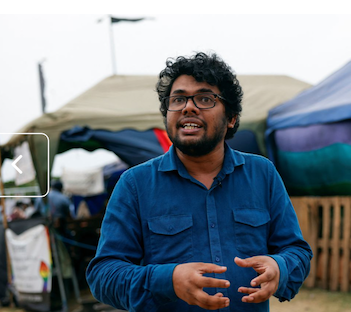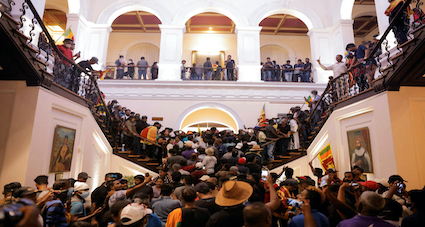A Reuters story—“How a band of activists helped bring down Sri Lanka’s government” —deserves your attention.
It tells about a Catholic Priest, a digital strategist and a popular playwright who got together in a seaside tented camp in Colombo to inject life in the protest movement, widely known as “Aragalaya” (Struggle) which was tapering down after the initial frenzy on rising fuel costs.
The Reuters report mentions that their plan succeeded beyond the wildest dreams.
They used Social Media giant Facebook—some 8 million active accounts in Sri Lanka—to reach practically every part of Sri Lanka.
The online agitation was combined with bringing Opposition political parties, labour unions and student groups, including the influential University Students’ Federation (IUSF) —not to forget door-to-door campaigning to get enough people back on the streets for a final push, as the Priest-Digital Strategist-Playwright shared with the Reuters.
The IUSF has a reputation for its political agitation and clashed with security forces during recent protests, dismantling police barricades amid teargas and water cannons.
The Aragalaya group also asked volunteers to visit thousands of homes across parts of Colombo, including middle-class government housing estates.
They reckoned that if enough people were brought on to the gates of Presidential Palace, some 10,000 would be enough to overpower the security personnel.
And so it happened as the security personnel guarding each of the four entry points to the president’s house were overpowered.
And it all happened after they successfully dismantled police barricades, water cannons, and took apart the tall gates guarding the president’s house.
The Reuters story is heavily based on the version of Chameera Dedduwage (image below) , the digital strategist, who if you look up at his profile on LinkedIn has had a stint with People’s Action for Free and Fair Elections in Sri Lanka (PAFFREL), an election organisation funded by the US’ based National Endowment for Democracy (NED).

Now what is National Endowment for Democracy (NED)?
At this stage, I would like to take you to another article, this time by New York Times: “U.S. Groups Helped Nurture Arab Uprisings”.
The article admits the regime changes in the Arab world, what is commonly known as “Arab Spring” were not spontaneous people’s uprising but that the United States spent years in advance in engineering it.
It mentions some Egyptian youth leaders who attended a technology meeting in New York where they were trained to use social media and networking—the toolkit gangs.
Among those promoting this meeting were Facebook, Google and the US State Department.
If the US State Department disagrees with some opinion, the Facebook would shut it down. You would be banned, booted out of Facebook (A FB ban which I am presently undergoing for presenting the Russian viewpoint on Ukraine, against the Western media’s propaganda). Your reach would be buried by the Facebook algorithm.
So if a movement is being helped along by the Facebook, you know they are congruent with the US State Department.
In the NYT article, there is also names of individuals and groups who were directly involved in the upheaval we call “Arab Spring”. Some of the names mentioned are: International Republic Institute, National Democratic Institute and Freedom House etc.
All these organisations operate under the umbrella known as US National Endowment for Democracy. This is funded by the US Congress.
NED is America’s regime change organization, so to say. It funds and supports regime change around the world under the smokescreen of promoting democracy.
If you google search for Board of Directors of NED, there are names such as Elliott Abrams, the one who is accused of covering up death squads in Latin America. There is Scott Carpenter who was virtually running Iraq after the US invasion threw out the Saddam Hussein regime. And there is Victoria Nuland, presently the Under Secretary of State, but one who brought about the regime change in Ukraine in 2014 which has now worsened to the present conflict.
Sure, Lanka’s protests were genuine.
People were exasperated with the rising prices.
The Sri Lankan government, reeling under the debt—by the way, owned largely to Western institutions and not China as is the mainstream narrative—were unable to meet the people’s expectations.
But things were dying down before it was sparked by the typical toolkit which the US-backed bodies and Social Media giants use to overthrow governments.
A puppet regime would now be installed in Sri Lanka. And that would be keep our part of world hugely destabilized, much to China and India’s concern; one which US sees as its main challenge and the other which it has so far been unable to make fall in line.
Now the thing to remember in this entire episode—and pertinently for the Modi government is that it would have to use a heavy hand if and when such protests gather pace.
They are not spontaneous but engineered in which Social Media giants, Opposition, NGOs, Human Rights Group, Islamists, Leftists and Ultra Student Groups all combine to raise a storm.
And if the Centre, keeps ceding space to them, and Judiciary is a mere spectator, before long these funded protestors would be at your Gate and a regime change would’ve been engineered.
One sincerely hopes that if the Indian government wants to be “atmanirbhar”, and as it has shown in its support to Russia on the Ukraine conflict, it would be foolhardy to believe that a hegemon like the United States won’t butt in.
All the famous tools which erupt as they have done in Hong Kong, Kazakhstan, Pakistan and Sri Lanka recently, would be tried on India, the glimpse of which we saw in anti-CAA and Farmers’ Protest in last three years.


